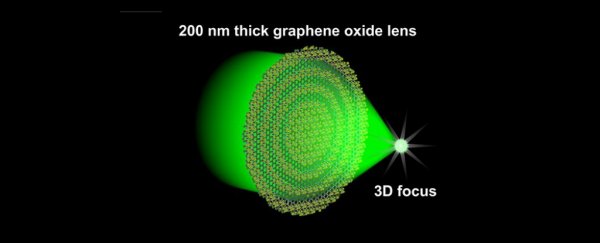Researchers have used graphene to create a lens that's so flat, it's 300 times thinner than a sheet of paper and weighs just 1 microgram. That means it's small enough to split a beam of single photons - something that's going to be crucial if we ever want to develop optical computers that process data at the speed of light.
These optical computers require devices called photonic chips, which store information as photons rather than electrons, and allow that information to move at light speed - and people are pretty excited about it. NASA is already using it, and the technology is getting more and more impressive. But there are still some limitations, and one of those is having lenses thin enough to split beams of light and divert them around the chip.
Attempts to make these lenses in the past have required expensive and impractical materials such as gold, but researchers at Swinburne University of Technology in Australia have been working on a solution, and they've managed to produce a lens using graphene oxide that's not only thin enough to overcome the diffraction limit, but is also cheap, strong, flexible, and easy to produce.
Only a few months ago, a study was published in Nature Communications about these awesome graphene ultra-thin lenses, but the researchers are already on their way to improving the technology further.
As we said at the time:
"Why does that matter, you may ask? Well, think of it this way: the new lens could be used to build devices capable of viewing, manipulating, monitoring, and trapping the tiniest particles in real time. In other words, it has the potential to revolutionise the technology used in medical diagnosis and treatment, imaging, sensing, and even computing."
Not only will this research be able to boost the efficiency and speed of photonic chips, but it's also able to be used a little closer to home - in our phones. Smart phones with cameras could have their size and weight reduced, as the cameras in our phones are currently weighed down by heavy and thick lenses.
And these graphene lenses also have a whole range of other properties that could be useful for medical research and imaging - they can focus near the infrared spectrum, allow thermo-imaging and could even be able to do remote medical diagnosis.
"Our lens concept has a 3D subwavelength capability that is 30 times more efficient, able to tightly focus broadband light from the visible to the near infrared, and offers a simple and low-cost manufacturing method," said lead researcher Baohua Jia, from Swinburne's Centre for Micro-Photonics. The team is now looking at integrating the lens with fibre to create a smaller, safer and more sophisticated endoscope for medical procedures.
Just in case that isn't enough, the technology is also able to be used in nanosatellites to make them lighter, and better at focusing on Earth. These nanosatellites are tiny box-shaped satellites weighing between 1 and 10 kilograms. It's able to perform the functions that normal satellites do, but costs less to launch and can even be faster than micro or regular satellites.
"We feel very excited about it," said Jia. "My team wants to let the world know that we have this fantastic technology and that it will be useful and change their lives."
Swinburne University of Technology is a sponsor of ScienceAlert. Find out more about their innovative research.
